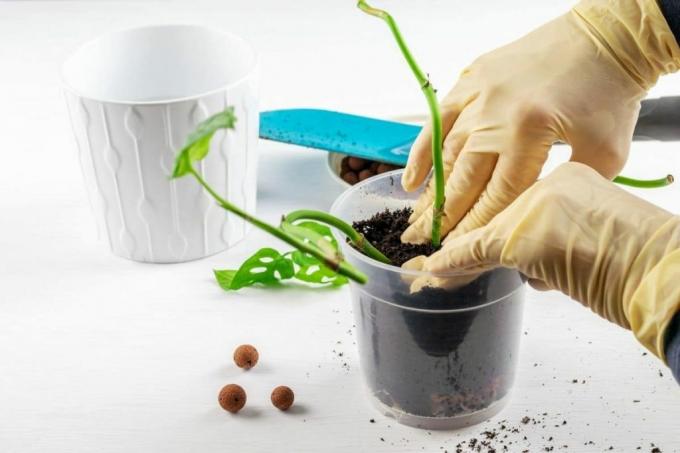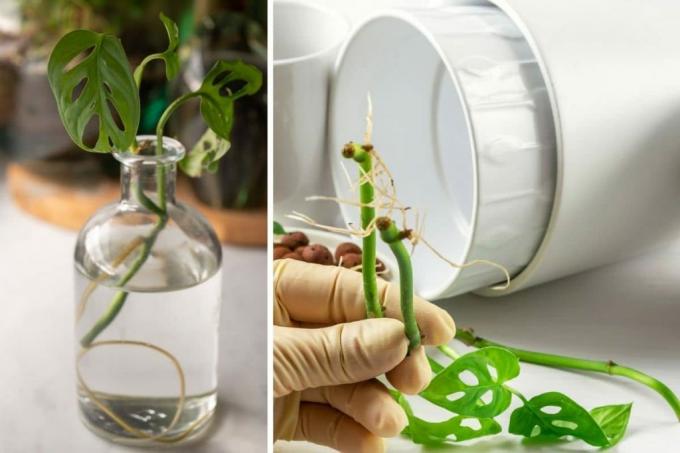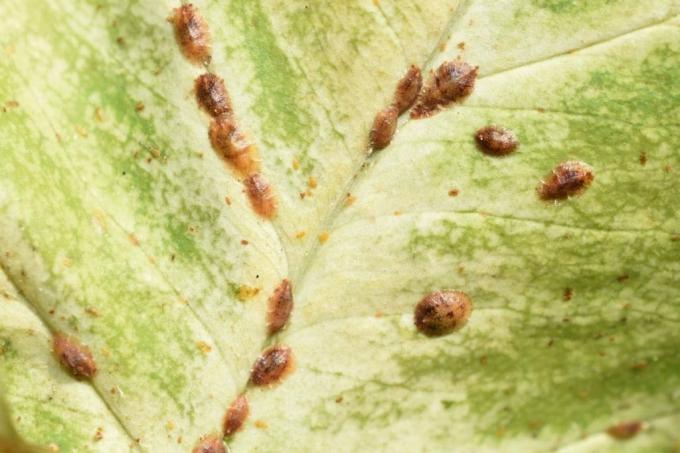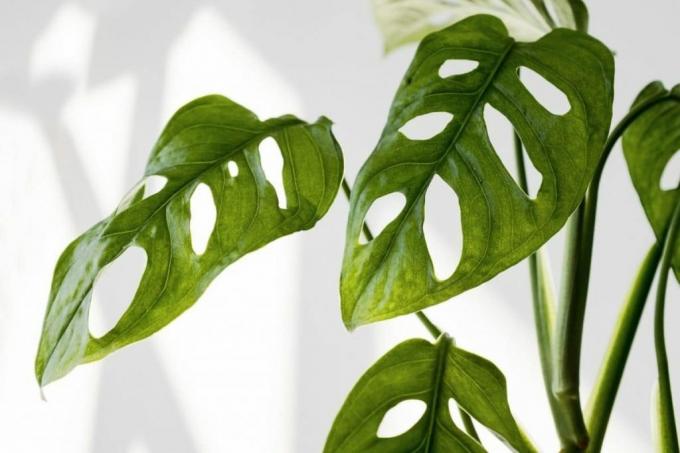
table of contents
- origin
- Location
- Substrate
- to water
- Fertilize
- Repot
- Cut
- Multiply
- Overwinter
- Toxicity
- Diseases and pests
- frequently asked Questions
Profile and care information open +conclude -
- Flower color
- White
- Location
- Bad, sunny
- Growth habit
- Climbing Plant, Perennial, Overhanging
- height
- 50 to 300 centimeters
- Soil type
- sandy, loamy
- Soil moisture
- moderately dry, moderately moist
- PH value
- weakly alkaline
- Limescale tolerance
- Calcium tolerant
- humus
- rich in humus
- Poisonous
- Yes
- Plant families
- Arum family, Araceae
- Plant species
- Climbing plants, Potted plants, Houseplants
- Garden style
- Pot garden, winter garden
Hardly any other houseplant has such decorative leaves as the Monstera obliqua 'Monkey Leaf'. It improves the indoor climate, is easy to care for and beautifies every room. Please note our care tips!
origin
The Monstera obliqua 'Monkey Leaf', also known as the 'Monkey Mask', is the little sister of the well-known window leaf. The climbing plant originally comes from the tropical and subtropical regions of South America. While the Monstera leaves usually have holes up to the edge, this variety has closed leaf edges. According to traditional stories, the climbing plant got its unusual name because of itself a monkey hid behind the large leaves when a botanist hid the plant in the jungle tracked down.
Location
The holey Window leaf comes from tropical regions. A warm, bright location best meets the requirements of the plant. It also thrives in partially shaded places, but it does not grow as quickly there and the leaves remain smaller. The houseplant does not tolerate direct sunlight.

Place the Monstera on a plant stool or on an insulating mat. The plant is sensitive to cold feet. The floor temperature should be at least 18 degrees Celsius. In the winter garden with high humidity, the window leaf unfolds its full beauty.
Note: The monstera is a climbing plant. It can be led upwards with a climbing aid or it can grow hanging in a hanging basket.
Substrate
Use common green potting soil for your window leaf. Pour a layer of expanded clay into a sufficiently large flower pot for drainage. It develops splendidly in Hydroponics.
to water
The window leaf must not be poured too much or too little. Make sure that the soil does not dry out completely and avoid waterlogging. When the substrate surface is dry, the time is right for watering. Use room warm water that is as soft as possible.

Tip: The green plant needs high humidity for its development. Set up humidifiers, spray the leaves, or regularly rub them with a damp rag.
Fertilize
Like most fast-growing plants, the Monstera obliqua 'Monkey Leaf' has a high nutritional requirement. Fertilize every two weeks with liquid green plant fertilizer that you add to the irrigation water. Long-term fertilization with fertilizer sticks is also possible.
No fertilization is required during the winter rest phase. You should not begin to give nutrients regularly until spring.
Tip: We recommend hydroponics for the window leaf. Modern systems ensure a continuous supply of water and nutrients.
Repot
Plant the fast-growing Monstera obliqua 'Monkey Leaf' annually or every two years in spring in a pot of fresh house plant soil. She thanks for this with a magnificent growth.

instructions
- Cut back large plants before repotting
- use a clean, sharp knife
- Take the plant out of the pot, shake off the soil from the root ball
- remove diseased and rotten roots
- shorten long roots
- put in a larger pot with drainage and fresh substrate
Tip: When repotting, you can divide the plant immediately. A monstera is always a welcome gift.
Cut
A pruning of the houseplant is not absolutely necessary for development. However, it grows so quickly that it has to be cut back every now and then. In no case do not prune the aerial roots. If these disturb you, divert them into the potting soil.
Multiply
The window leaf can be propagated easily by forming cuttings. We recommend taking cuttings when repotting.
instructions
- Take the plant out of the pot
- choose a leaf with an aerial root on the stem
- Cut off the trunk below the aerial root
- Let all parts of the plant dry overnight
- put in a pot with potting soil
- pour on
- put in a warm place
- keep moist

Alternatively, you can put the cutting in a vase with water. This option is perfect for teaching children in the household the development of the new plants. You can see the root formation day after day. Plant the cutting in potting soil when the roots are one to two inches long.
Note: Take an offshoot of your Monstera 'Monkey Mask' with you to the office. Scientific studies have proven the indoor air-improving properties of the houseplant. In hydroponics, caring for the undemanding plant is no problem even during the holiday season.
Overwinter
The holey window leaf is mostly used as a houseplant. Fertilization should be stopped in winter. Monstera that have spent the summer on the terrace spend the winter in bright, warm rooms in the house. Even in the cold season, the plants need moisture and light.
Toxicity
The leaves, flowers, fruits and roots of the window leaf contain oxalic acid and other toxins. Especially sensitive people and Pets must be protected from contact. Therefore, place the houseplant inaccessible to small children.

Diseases and pests
Spider mites
Decorative leaf plants such as the Monstera obliqua 'Monkey Leaf' are often attacked by spider mites (Tetranychidae) in dry rooms. Especially in winter, when the heating air is warm, the Pests active. The fine webs that cover the shoots and leaves are recognizable. Spider mites feed on the sap. Light spots remain in the places where they have vacuumed.
- Recommendation: Thoroughly rinse infested plants with water. Then wrap it completely in a sealed foil pouch. In this way a greenhouse climate develops. The high humidity kills the rest of the scale insects. After two weeks you can free the Monstera from the foil packaging.
As a preventive measure, we recommend wiping the leaves regularly with a damp cloth and preventing the substrate from drying out. Humidifiers or bowls with water ensure a higher level of humidity in the room, which is pleasant for both plants and people.
Scale insects

Sticky, shiny spots on the leaves of the Monstera indicate an infestation with scale insects (Coccoidea). Deformed or withering leaves can be the result of the pest that slows photosynthesis. Often the tiny ones sit insects in dense clusters on stems and in the leaf axils.
- Recommendation: Thoroughly wipe the scale insects off. Rinse the affected plant with water and place it separately from other indoor plants.
Incorrect site conditions can be the cause of scale insect infestation. Place the plant in a bright place with high humidity. Provide them with regular water. Do not fertilize too heavily. Weakened plants are more likely to be attacked by pests.
Note: Only buy quality potting soil for your indoor plants. Often, larvae or eggs of pests are found in cheap products. Always check potting soil for abnormalities.
sunburn

Indoor plants on the windowsill respond to direct sunlight with bright spots on the leaves.
- Recommendation: Protect the Monstera 'Monkey Mask' from sunburn. Place the plant in a bright place, but protected from direct sun.
Eye spot disease
If you suddenly see brown spots with a light center on the leaves of your Monstera that continue to spread, it is likely that they are Eye spot disease. This is caused by the fungus Spilocaea oleagina.
- Recommendation: Cut off any infected leaves. Treat the plant with a fungus remedy from a horticultural store.
Prevent the fungal attack by pouring horsetail brew.
frequently asked Questions
If your 'Monkey Leaf' monstera is not making holes in the leaves, move it to a lighter spot. In dark locations, the houseplant grows more slowly and only forms smooth, completely closed leaves.
The window leaf is perfectly suited for the bucket culture. Magnificent specimens develop in a place protected from direct sun on the terrace. Spray the container plant with water on hot days. The plant tolerates rain well, but waterlogging must be avoided at all costs.
In warm and humid tropical regions, the window leaf forms creamy white bulb flowers surrounded by a bract. If the plants are cultivated indoors, the flowers often fail to appear. In bright winter gardens with high humidity, with good care and with a little patience, healthy plants also impress with elegant flowers in indoor culture.
